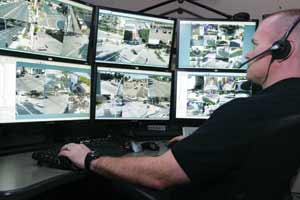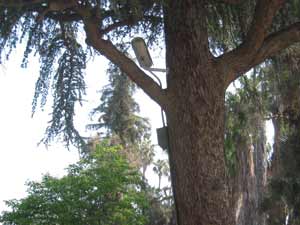Enter the Cameras

Redlands, Calif., has deployed citywide surveillance, and police dispatchers can access the system at their console. One console is dedicated to video surveillance.
By Russ Dalzell & Ray Leblond
Prospect Park in Redlands, Calif., is a charming and beautiful wooded area that hosts the yearly Redlands Theatre Festival. But it wasn’t always a desirable place for an afternoon stroll or a place to spend Sundays with your family.
For too long, the park was a prime location for drug-related crimes. Trees, benches and structures were covered with graffiti on a random basis; fires were set to theatre kiosks and split rail fences; trees were vandalized with axes; unsavory visitors were shooting up drugs on the Carriage House patio; inappropriate sex and alcohol use were rampant; and, worse yet, teenagers would smoke pot in the upper picnic area while families walked by with their toddlers. Sadly, that was becoming a typical day in Prospect Park—that is, before the “cameras.”
Chief Jim Bueermann believed the solution for making Prospect Park and other troubled areas of the city safe again for its citizens was to enhance the ability of his police force with the aid of cutting-edge technology in the form of a video surveillance system. He believed such a solution could assist the police in proactively suppressing, intervening and, ultimately, preventing crime.
The surveillance system includes a series of cameras focused on various areas throughout the park, including scenic overlooks, restroom areas, the amphitheater and the Carriage House. The dynamic system combines one-way audio, motion and physical tripwires with state-of-the-art video analysis to detect trouble as it occurs. Staff can visually monitor the areas from the Redlands Police Department dispatch center miles away, communicate in real time with offenders and dispatch on-duty officers if necessary.
A staff comprising volunteers, dispatchers and police officers monitors the cameras 24/7, but primarily after hours in an effort to curtail or screen for trouble.
Initially, the telecommunicators expressed trepidation. They feared the system would represent “just one more monitor” they’d have to pay attention to. Some were more amenable to the idea than others, and truly embraced the concept. The system soon proved its worth.
The Prospect Park surveillance system represents a partnership between the PD and Friends of Prospect Park, an organization that represents this historical landmark within the city, and the Redlands Theatre Festival. This project is one of many that expand the PD’s ability to ensure public safety and enhance the quality of life of its citizens.

This tree cam in Prospect Park is camouflaged so park users don't even realize it's there. It also has trip wire analytics.
Results
The results of this collaborative effort have been astounding. “No one involved in this project expected the troublemakers and problems of the park to go away immediately,” says Kristin Saukel, president, Friends of Prospect Park, “but it was hoped the word would get out and things would improve over time. However, the positive impact of the park surveillance system installation and monitoring was immediate. Almost overnight the graffiti and vandalism stopped, even in areas not monitored by the system.”
Nearly one year later, the benefits are still noticeable. According to Chief Jim Bueermann, the first Saturday night the cameras were operational, between 9 p.m. and 3 a.m., Redlands Police Department used the park speakers to tell 36 people to leave the park. All complied. The number of nighttime encounters has steadily decreased over the ensuing months.
“The volunteers working in the park certainly feel safer and have noticed the decrease in hoodlums and trouble within the park,” Saukel says.
Comments about the new cameras from park visitors have been positive. In fact, most are completely unaware of the surveillance system, with cameras scattered strategically throughout the park, unless it’s pointed out to them.
Citywide Efforts
The Prospect Park surveillance system is one of many such systems covering the downtown core, parks, city facilities, the jail and several schools. Although each is independent, the systems collectively support a unified citywide surveillance strategy. Surveillance is conducted in real time, resulting in crime prevention and valuable information regarding crimes in progress. Reduction of nuisance crimes, such as vandalism, is dramatic, particularly with the use of audio. The systems have allowed two parks to be reclaimed for citizens.
Chief Bueermann is a strong advocate of integrating technology into policing and readily admits that he tends to push the limits of technology to achieve his vision.
Redlands had attempted to deploy video surveillance a few times in the past, but in 2006 it embarked on the foundation of the system that exists today. Chief Bueermann realized that a successful implementation would begin with the selection of a technology firm capable of thinking outside the box.
Lt. Russ Dalzell (retired) provides some insight: “Our past experiences with the deployment of wireless video cameras taught us some very valuable lessons regarding the complexity of the technology and the absolute need to employ the services of an experienced integrator for a project which would require the seamless integration of so many disparate technologies.”
The program included dedicating a full-time police department employee to gain the trust of dispatchers and field officers, and to act as a liaison between the technology partner and the community. Dalzell filled that role and is instrumental in the success of the overall system.
It was imperative that the support of the city council and citizens of Redlands be gained. The formation of a privacy committee addressed that need. The committee weighs in on the current and future plans of the system, and has access to it, providing input and oversight.
This citywide surveillance strategy got started with four cameras installed in downtown hot spots. Police dispatchers monitored the video. Almost immediately, the department was rewarded with solid results. A crime was captured in progress on the video monitoring system. Real-time surveillance video confirmed the silent alarm and allowed the police dispatcher to provide live information to officers responding to the call. In effect, the video acted as additional manpower, and provided the officers on scene with constant and immediate location updates. Officers were then able to apprehend the suspects.
The four downtown cameras received press coverage, including local papers and television news. The capture and arrest of a DUI suspect demonstrated the integral role of a successfully deployed system. Support from citizens, businesses, city officials and the Redevelopment Agency was gaining momentum. Up next: an aggressive plan to expand the system to schools, the core downtown area and parks.
A Request for Proposal was developed. Locations were selected based on crime analysis data, proximity to potential crime locations and the ability to “bracket” an area should a crime occur within certain boundaries. The objective was to place cameras in locations where an officer would be needed and do it in a way that would allow dispatchers/video camera operators to act as virtual police officers, should a crime occur in the area.
At the conclusion of an exhaustive RFP process, the Redlands PD selected Leverage Information Services based on its demonstrated ability to design, engineer and construct an integrated IP-based surveillance system that would meet the very demanding specifications set forth by Chief Bueermann.
Because of the critical nature of the video deployment, the architecture had to be designed to achieve the highest possible degree of uptime and reliability. Ensuring minimal latency was also a high priority, as real-time, proactive intervention was one of the primary goals.
The Leverage architecture is a peer-to-peer design, meaning that each camera, viewing station and recording device operates independently. “A traditional client server system would not meet the objectives of high uptime and real-time surveillance in a pervasive citywide scalable architecture,” says the architect of Leverage’s IP Surveillance System, Ray Leblond. He goes on to say, “Redlands has contributed significantly to the development of our architecture by providing a real-time environment conducive for testing and validation of new capabilities.”
System reliability is an aspect the PD finds highly attractive. It will function even in adverse conditions, such as individual component outages during power failures. The potential impact of environmental and man-made events was taken into consideration during the architecture’s construction and design. The result is a system with high uptime and overall continuing functionality even if one or more components become inoperative.
The system is primarily wireless. All of the remote locations at some point transverse a wireless infrastructure. Establishing the wireless infrastructure was a high-priority task. The system is isolated from the police department network. A natural separation for these systems exists when the mission of video surveillance is considered. Traditional network security measures, such as VPN access for remote users and wireless encryption for the data path, were implemented. Password authentication for the surveillance system and audit log functions provides checks and balances.
Storage of the video recordings is an important aspect of the system for legal reasons, specifically for potential documentation for any court cases that occur as a result of the video surveillance. The system records locally at the camera and, at the same time, in various other locations in the city. Collectively, the recording devices provide a high degree of assurance of preservation of surveillance video. When an incident is identified, it’s exported from the network video recorder to a longer term storage area.
The video surveillance system is primarily used as a proactive tool. However, post-incident capabilities remain key. Live or recorded video can be viewed anywhere on the network, including on a laptop in the field. The system is incredibly scalable and highly functional. Surveillance capabilities can cover any area of the city’s 42 square miles and integrate into existing systems from other organizations, such as schools and businesses.
Citizens want to feel confident about their safety. Depending on the numbers, the city’s crime statistics can bolster or erode citizen confidence and affect their quality of life. Put simply, public safety is tightly connected to an individual’s view of their quality of life within their city.
Creative thinking and innovation have made Redlands a template for improving quality of life. At the time this article is being written, additional capabilities, including providing video to iPhones and transmitting video from the Redlands PD airplane, are in process.
Cutting-edge thinking, leadership and technology have a home—Redlands.
Stay Tuned
Next month, part 2 of this series will describe the implementation plan and technology used.
About the Authors
Lt. Russ Dalzell is retired from the Redlands (Calif.) Police Department (http://www.ci.redlands.ca.us/).
Ray Leblond is IP surveillance practice manager for Leverage Information Systems. Contact him at 800/825-6680.
Originally published in APCO International’s Public Safety Communications magazine, 77(04):34-37, April 2011.
Related Link

